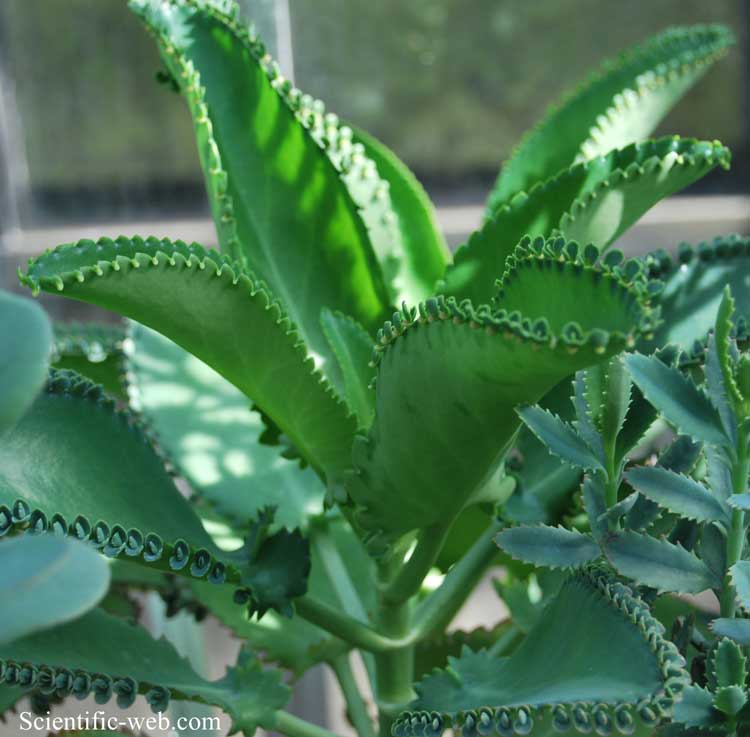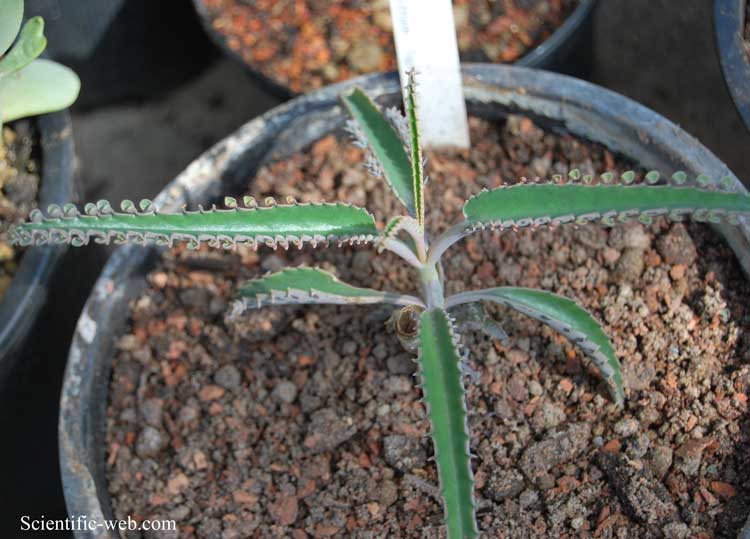
Kalanchoe daigremontiana, Photo: Michael Lahanas
Classification System: APG IV
Superregnum: Eukaryota
Regnum: Plantae
Cladus: Angiosperms
Cladus: Eudicots
Cladus: Core eudicots
Ordo: Saxifragales
Familia: Crassulaceae
Subfamilia: Kalanchoideae
Genus: Kalanchoe
Subgenus: K. subg. Bryophyllum
Species: Kalanchoe daigremontiana
Name
Kalanchoe daigremontiana Raym.-Hamet & H.Perrier, Ann. Mus. Colon. Marseille, sér. 2, 2: 128–132 1914.
Synonyms
Bryophyllum daigremontianum (Raym.-Hamet) & (H.Perrier) A.Berger
Hybrids
K. × houghtonii
Distribution
Native distribution areas:
Continental: Africa
Regional: Western Indian Ocean
SW-Madagascar

Kalanchoe daigremontiana, Photo: Michael Lahanas
References: Brummitt, R.K. 2001. TDWG – World Geographical Scheme for Recording Plant Distributions, 2nd Edition
References
Primary references
Raymond-Hamet & Perrier de la Bâthie, H.,1914. Annales du Musée Colonial de Marseille, 2: 128.
Links
Hassler, M. 2019. Kalanchoe daigremontiana. World Plants: Synonymic Checklists of the Vascular Plants of the World In: Roskovh, Y., Abucay, L., Orrell, T., Nicolson, D., Bailly, N., Kirk, P., Bourgoin, T., DeWalt, R.E., Decock, W., De Wever, A., Nieukerken, E. van, Zarucchi, J. & Penev, L., eds. 2019. Species 2000 & ITIS Catalogue of Life. Published on the internet. Accessed: 2019 November 27. Reference page.
Govaerts, R. et al. 2019. Kalanchoe daigremontiana in Kew Science Plants of the World online. The Board of Trustees of the Royal Botanic Gardens, Kew. Published on the internet. Accessed: 2019 November 27. Reference page.
International Plant Names Index. 2019. Kalanchoe daigremontiana. Published online. Accessed: November 27 2019.
Tropicos.org 2019. Kalanchoe daigremontiana. Missouri Botanical Garden. Published on the internet. Accessed: 2019 November 27.
USDA, ARS, Germplasm Resources Information Network. Kalanchoe daigremontiana in the Germplasm Resources Information Network (GRIN), U.S. Department of Agriculture Agricultural Research Service.
Vernacular names
Deutsch: Brutblatt
English: Devil's Backbone
español: Espinazo del diablo
magyar: Sarjika, elevenszülő korallvirág
Kalanchoe daigremontiana, formerly known as Bryophyllum daigremontianum and commonly called mother of thousands, alligator plant, or Mexican hat plant is a succulent plant native to Madagascar. Like other members of Bryophyllum (now included in the genus Kalanchoe[1]), it can propagate vegetatively from plantlets that develop on its leaf margins. All parts of this species contain a very toxic steroid known as daigremontianin.[2][3]
It is often confused with K. laetivirens, K. delagoensis and K. × houghtonii. The leaves of K. laetivirens are completely green, while K. daigremontiana has bands or spots on the back of leaves. The leaves of K. delagoensis are linear, while K. daigremontiana has lanceolate, oblong, ovate or triangular leaves. K. × houghtonii is a hybrid between K. daigremontiana and K. delagoensis, therefore has characteristics in between; its leaves are narrower than those of K. daigremontiana, and its leaf base is attenuate, cuneate to weakly cordate or auriculate, while K. daigremontiana has strongly cordate to auriculate or even peltate leaves.[4]
Morphology
Plants grow up to 1 m (3 ft 3 in) tall[5] and have opposite and whorled, fleshy oblong-lanceolate leaves which grow up to 20 cm (8 in) long and 32 mm (1+1⁄4 in) wide. They are green above and blotched with purple underneath. Leaf margins have spoon-shaped bulbiliferous spurs which bear plantlets which may form roots while still attached to leaves.[6]
A plant may also develop lateral roots on its main stalk, as high up as 10–15 cm above the ground. A plant's upper leaves may grow large, causing its main stalk to bend downward. Then the lateral roots may enter soil and new vertical shoots may grow from the original shoot. Kalanchoe daigremontiana can spread by both seeds and by plantlets dropped from its leaves.
Kalanchoe daigremontiana has an umbrella-like terminal inflorescence (a compound cyme) of small bell-shaped, grayish pink (or sometimes orange) flowers. Flowering is, however, not an annual event and occurs sporadically if at all on some shoots. Particularly in climates with distinct seasonal temperature differences, flowering is most frequently observed at the beginning of a warm season. Indoor plants, as well as balcony plants which have been moved inside to survive the cold season, begin flowering in early winter.
As a succulent plant, K. daigremontiana can survive prolonged periods of drought with little or no water. During growth periods with higher temperatures and increased water supply, this species requires proper nutrition, without which leaves show deficiency symptoms such as crippled growth and pustule-like lesions. The plant is not frost-hardy and typically dies in places where temperatures are below freezing.
Physiology
Plants of the genus Kalanchoe as well as many other plants growing in arid regions photosynthesize via Crassulacean acid metabolism.
Distribution
Kalanchoe daigremontiana is native to the Fiherenana River valley and Androhibolava mountains in southwest Madagascar. It has been introduced to numerous tropical and subtropical regions, such as Florida, Puerto Rico, Hawaii, Venezuela, Argentina, Brazil, Uruguay, and parts of southern Europe.
Habitat
Kalanchoe daigremontiana prefers to grow in rocky and dry places.
It can become an invasive plant and threaten natural ecosystems, especially in arid and semi-arid environments (South Africa and regions of South America for example), where it can inhibit native-plant recruitment.[7]
References
"Kalanchoe daigremontiana Raym.-Hamet & H.Perrier". Plants of the World Online. Kew Science. Retrieved 2020-10-09.
Wagner, Hildebert; Fischer, Manfred; Lotter, Hermann (1985). "New Bufadienolides from Kalanchoe daigremontiana Hamet et Perr. (Crassulaceae)" (PDF). Zeitschrift für Naturforschung B. 40 (9): 1226–1228. doi:10.1515/znb-1985-0920. S2CID 95146056.
McKenzie, R. A.; Armstrong, T. R. (1986). "Poisoning of cattle by Bryophyllum plants". Queensland Agricultural Journal. 112 (3): 105–108. Retrieved 27 January 2016.
Shaw, J.M.H. (2008). "An investigation of the cultivated Kalanchoe daigremontiana group, with a checklist of Kalanchoe cultivars" (PDF). Hanburyana. 3: 17–79.
Burnie, David (1998). The DK Nature Encyclopedia. New York: DK Publishing, Inc. pp. 29. ISBN 0-7894-3411-3.
Batygina, T. B.; Bragina, E. A.; Titova, G. E. (1996). "Morphogenesis of propagules in viviparous species Bryophyllum daigremontianum and B. calycinum". Acta Societatis Botanicorum Poloniae. 65 (1–2): 127–133. doi:10.5586/asbp.1996.022.
Herrera, Ileana; Ferrer-Paris, José R.; Hernández-Rosas, José I.; Nassar, Jafet M. (2016). "Impact of two invasive succulents on native-seedling recruitment in Neotropical arid environments". Journal of Arid Environments. 132: 15–25. Bibcode:2016JArEn.132...15H. doi:10.1016/j.jaridenv.2016.04.007. Retrieved 6 May 2016.
Literature
Everitt, J. H.; Lonard, R. L.; Little, C. R. (2007). Weeds in South Texas and Northern Mexico. Lubbock: Texas Tech University Press. ISBN 978-0-89672-614-7.
photos of inflorescences
United States Department of Agriculture
plantoftheweek.com
Poisonous houseplants
Retrieved from "http://en.wikipedia.org/"
All text is available under the terms of the GNU Free Documentation License

